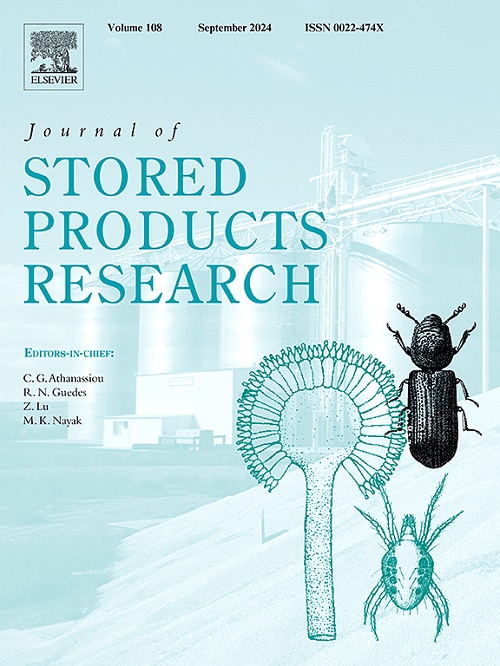四种精油对两种储存品昆虫——灰蛾蛾(鞘翅目:拟甲科)和拟甲蛾(拟甲科)的药效研究:实验和计算机方法
IF 2.7
2区 农林科学
Q1 ENTOMOLOGY
引用次数: 0
摘要
灰蛾(Fabricius, 1792)(鞘翅目:虫虻科)和castaneum (Herbst, 1797)(鞘翅目:拟甲科)是影响储藏产品质量、数量和商业价值的两种主要害虫。本研究通过化学成分、接触毒性、对昆虫表皮结构的影响以及与乙酰胆碱酯酶和细胞色素P450的硅相互作用,评价了加氢蒸馏法提取的苦艾、苦楝果、三角Trigonella foenum-graecum和苦楝种子精油的杀虫效果。气相色谱-质谱分析结果表明,该药材的主要成分为表苯二酚(28.78%)、棕榈酸(15.07%)、二氢放线素(10.84%)和百里香酚(9.56%);苦艾草EO中樟脑(36.22%)和α-图琼(30.28%);苦楝籽提取物中含有己酸(57.85%)和本文章由计算机程序翻译,如有差异,请以英文原文为准。
Exploring the efficacy of four essential oils as potential insecticides against two stored-product insects, Rhyzopertha dominica (Fabricius) (Coleoptera: Bostrichidae) and Tribolium castaneum (Herbst) (Coleoptera: Tenebrionidae): Experimental and in silico approaches
Rhyzopertha dominica (Fabricius, 1792) (Coleoptera: Bostrichidae) and Tribolium castaneum (Herbst, 1797) (Coleoptera: Tenebrionidae) are two major insect pests whose damage affects the quality, quantity, and commercial value of stored products. In the present study, the effectiveness of essential oils (EOs) extracted by the hydrodistillation method from Artemisia absinthium aerial parts, Melia azedarach fruits, Trigonella foenum-graecum, and Peganum harmala seeds as insecticidal agents was evaluated by examining their chemical composition, contact toxicity, and effect on the structure of the insect cuticle, as well as their in silico interactions with acetylcholinesterase and cytochrome P450. The GC-MS results revealed that the major compounds of the investigated EOs were epicubenol (28.78 %), palmitic acid (15.07 %), dihydroactinolide (10.84 %), and thymol (9.56 %) for T. foenum-graecum EO; camphor (36.22 %) and α-thujone (30.28 %) for A. absinthium EO; capronic acid (57.85 %) and ç-Caprolactone (9.44 %) for M. azedarach EO; α-pinene (29.38 %), (9E),12(Z) linoleic acid (14.00 %) for P. harmala EO. A. absinthium EO caused high contact toxicity against R. dominica (LC50 = 3.37 μL/mL, LC90 = 6.23 μL/mL) and T. castaneum (LC50 = 5.15 μL/mL, LC90 = 8.52 μL/mL) after 96 h of exposure. These results were confirmed by the micrographs obtained by scanning electron microscopy (SEM), revealing significant cuticular lesions in both insects treated with A. absinthium EO. Additionally, the in silico molecular approach showed that epi-cubenol and dihydroactinolide (the main compounds of T. foenum-graecum EO) have a binding affinity to the AChE and cytochrome P450 enzymes.
The EOs can create an agricultural biopesticide formulation with contact toxicity against R. dominica and T. castaneum.
求助全文
通过发布文献求助,成功后即可免费获取论文全文。
去求助
来源期刊
CiteScore
5.70
自引率
18.50%
发文量
112
审稿时长
45 days
期刊介绍:
The Journal of Stored Products Research provides an international medium for the publication of both reviews and original results from laboratory and field studies on the preservation and safety of stored products, notably food stocks, covering storage-related problems from the producer through the supply chain to the consumer. Stored products are characterised by having relatively low moisture content and include raw and semi-processed foods, animal feedstuffs, and a range of other durable items, including materials such as clothing or museum artefacts.

 求助内容:
求助内容: 应助结果提醒方式:
应助结果提醒方式:


